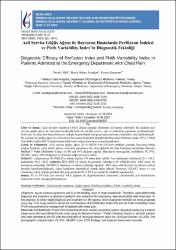Diagnostic Efficacy of Perfusion Index and Pleth Variability Index in Patients Admitted to the Emergency Department with Chest Pain
Citation
GÜLLÜ Durali,ARMAĞAN Hamit Hakan,KARAMAN KIVANÇ Diagnostic Efficacy of Perfusion Index and Pleth Variability Index in Patients Admitted to the Emergency Department with Chest Pain. Celal Bayar Üniversitesi Sağlık Bilimleri Enstitüsü Dergisi, vol.9, no.1, 2022, ss.38 - 41. 10.34087/cbusbed.946307Abstract
Objective: Acute coronary syndrome (ACS) is the leading cause of death worldwide. Therefore, rapid differential diagnosis and treatment is required in patients who present to the emergency department (ED) with chest pain. In this disorder, in which rapid diagnosis and treatment are life-saving, novel diagnostic methods are being proposed every day. This study aimed to reveal the contributions of the Perfusion Index (PI) and the Pleth Variability Index (PVI) measurements to management of patients with chest pain. Materials and Methods: PI and PVI measurements were carried out during routine clinical procedure by a trained triage nurse who was blinded to the study using the Masimo Radical 7 Pulse Oximetry Device in all adult patients who were admitted to the ED with the complaint of chest pain between April 1st, 2019 and October 1st, 2019. The demographic characteristics, PI, PVI, HEART score, ECG findings, and troponin levels were recorded. Results: A total of 154 patients, 96 (62.3%) of whom were males, were included in our study. The mean age was calculated as 55.1 ±18.2 years in men, 56.8 ±20.2 years in women, and 56.3±18.9 years in total. Of all patients, 66 (42.8%) were hospitalized with ACS diagnosis, and 88 (57.2%) were discharged from ED. The hospitalized patients had statistically higher values for Troponin, HEART score, and mean age. There was no difference between the two groups regarding PI and PVI. Conclusion: We think that the contributions of PI and PVI to emergency physicians in the management of patients who are evaluated with suspicion of ACS in the ED will be limited. Giriş ve Amaç: Akut koroner sendrom (AKS) dünya çapında ölümlerin en önemli sebebidir. Bu nedenle acil servise göğüs ağrısı ile başvuran hastalarda hızlı bir şekilde ayırıcı tanı ve tedavinin yapılması gerekmektedir. Hızlı tanı ve tedavinin hayat kurtarıcı olduğu bu patolojide her geçen gün yeni tanı yöntemleri öne sürülmektedir. Bu çalışma ile göğüs ağrısı ile acil servise başvuran hastaların değerlendirilmesinde Perfusion Index (PI) ve Pleth Variability Index (PVI) ölçümlerinin katkısının ortaya konulması amaçlanmaktadır. Gereç ve Yöntemler: Acil servise göğüs ağrısı ile 01/04/2019-01/10/2019 tarihleri arasında başvuran bütün erişkin hastalara rutin klinik işleyiş sırasında çalışmaya kör olan eğitimli bir triaj hemşiresi tarafından Masimo Radical 7 Pulse Oksimetre Cihazı ile PI and PVI ölçümü yapıldı. Hastaların demografik özellikleri, PI, PVI, HEART skoru, EKG bulguları ve troponin değerleri kayıt edildi. Bulgular: Çalışmamıza 96 (%62,3)’sı erkek, toplam 154 hasta dahil edildi. Yaş ortalaması erkeklerde 55.1 ±18.2, kadınlarda 56,8 ±20,2, toplamda 56,3±18,9 yıl olarak hesaplandı. Hastaların 66 (%42,8)’sının AKS tanısı ile hastaneye yatırıldığı, 88(%57,2) hastanın ise taburcu edildiği saptandı. AKS tanısı alan hastalar ile taburcu edilen hastalar karşılaştırıldığında; yatan hastaların istatistiksel olarak daha yüksek Troponin, HEART skoru ve yaş ortalaması sahip olduğu görüldü. İki grup arasında PI ve PVI açısından bir farklılık saptanmadı. Sonuç: PI ve PVI’nın acil serviste AKS şüphesi ile değerlendirilen hastaların yönetiminde acil hekimlerine katkısının sınırlı olacağı görüşündeyiz.
Source
Celal Bayar Üniversitesi Sağlık Bilimleri Enstitüsü DergisiVolume
9Issue
1URI
https://dergipark.org.tr/tr/download/article-file/1800513https://hdl.handle.net/20.500.12809/10254


















